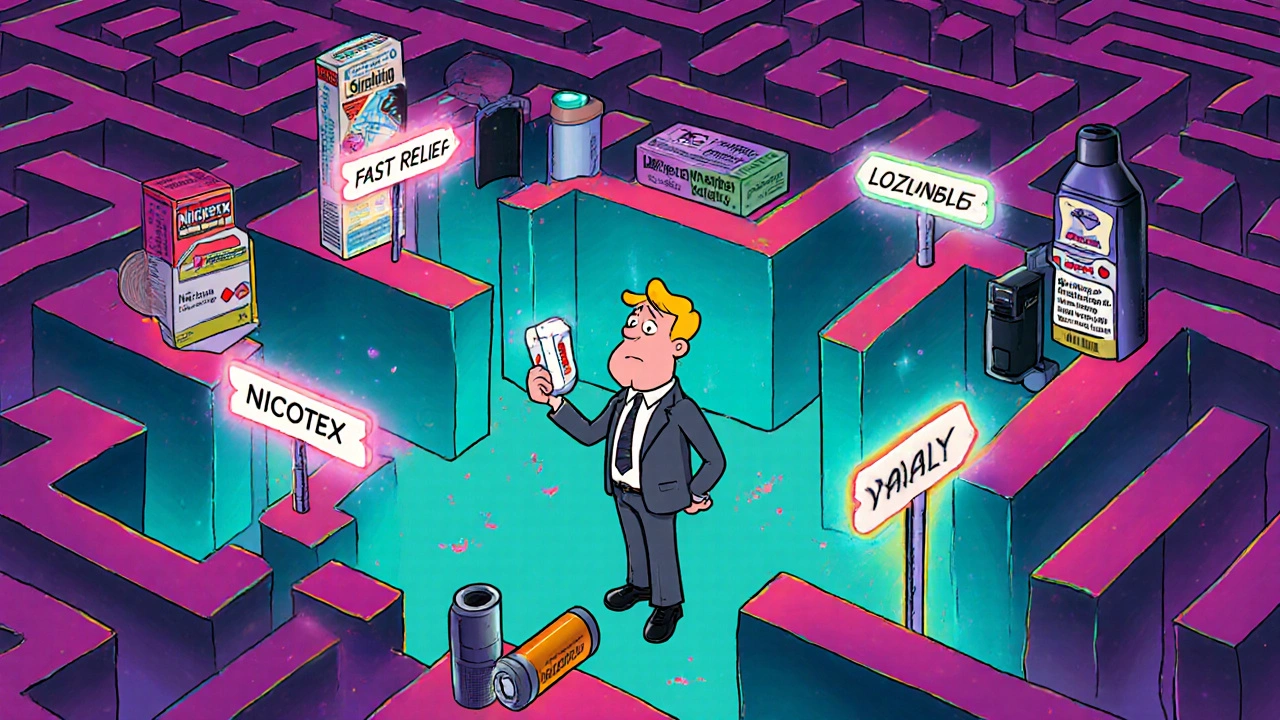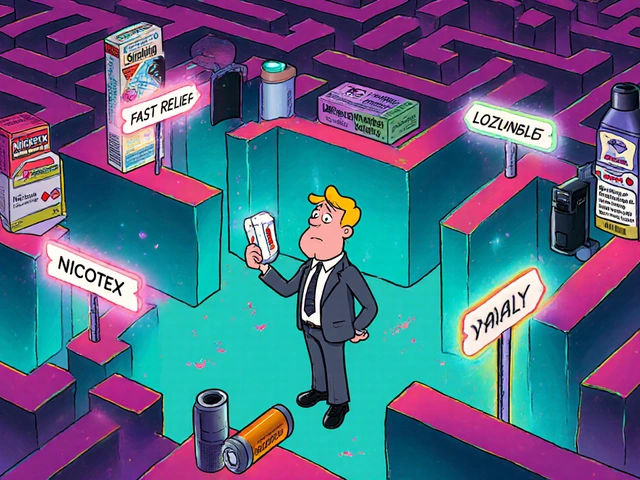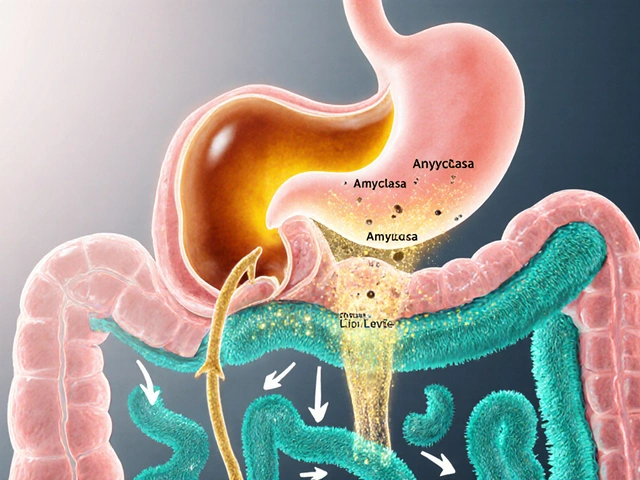NRT Cost & Effectiveness Calculator
Your Quit Profile
Key Considerations
Smoking rate: 10+ cigarettes/day suggests 4mg strength. Under 10 suggests 2mg.
Budget: Patches are generally cheapest per nicotine unit, while prescription meds are most expensive.
Preferences: Fast relief requires gum or inhaler; discreet needs lozenges or patches.
Recommended Option
Why this works for you:
Cost Comparison
| Option | Cost | Best For |
|---|
Trying to quit smoking can feel like navigating a maze of products, each promising a smooth exit. One name that pops up often is Nicotex, a nicotine replacement therapy (NRT) that’s marketed as a fast‑acting gum. But how does it really stack up against the other choices on the market? This guide breaks down the key differences, so you can pick the option that fits your lifestyle, budget, and cravings.
What is Nicotex?
Nicotex is a nicotine gum designed to reduce withdrawal symptoms and help smokers wean off cigarettes. It comes in 2 mg and 4 mg strengths, with a recommended chew‑and‑park technique: chew until you feel a mild tingling, then park the piece between your cheek and gum. The gum releases nicotine gradually, mimicking the spike you’d get from a cigarette but without the tar and carbon monoxide.
Unlike some NRT products that require a prescription, Nicotex is sold over the counter in many pharmacies across the UK and Europe. The packaging suggests a 12‑week program: start with higher‑dose pieces, then taper down as cravings fade.
How Nicotine Replacement Therapy (NRT) Works
At its core, Nicotine Replacement Therapy delivers controlled nicotine doses to ease the transition away from smoking
. By keeping nicotine levels in the bloodstream low but steady, NRT reduces the intensity of withdrawal while allowing brain receptors to reset. The goal isn’t to replace cigarettes forever, but to break the habit loop and eventually quit nicotine altogether.Most NRT forms-gum, patches, lozenges, inhalers-share these principles, yet they differ in delivery speed, convenience, and side‑effect profile. Understanding those nuances is crucial when you compare Nicotex with its rivals.
Major Alternatives to Nicotex
- Nicotine Patch: a transdermal patch that releases nicotine slowly over 16‑24 hours.
- Nicotine Gum (Other Brands): similar to Nicotex but available in various flavors and dosage options.
- Nicotine Lozenges: dissolve slowly in the mouth, offering a discreet way to dose.
- Nicotine Inhaler: a hand‑held device that mimics the hand‑to‑mouth motion of smoking.
- E‑cigarettes (Vaping): deliver nicotine via aerosol; the device’s flavor and nicotine strength are customizable.
- Prescription Medications: varenicline (Chantix) and bupropion (Zyban) target brain receptors directly.
- Behavioral Support: quitlines, counseling, and mobile apps that address the psychological side of addiction.
Decision‑Making Criteria
When you line up Nicotex against these alternatives, ask yourself five questions:
- How quickly do I need nicotine relief? (Fast‑acting vs. steady release)
- Do I want a discreet, non‑visible solution?
- What’s my budget for a 12‑week program?
- Am I comfortable with a prescription or prefer over‑the‑counter?
- Do I have specific health concerns (e.g., skin irritation, dental issues)?
Your answers will point you toward the product that balances effectiveness with convenience.

Side‑Effect Profile: Nicotex vs. Alternatives
Every nicotine delivery method comes with a trade‑off. Below is a quick snapshot of common side effects:
- Nicotex Gum: throat irritation, hiccups, jaw soreness, occasional nausea.
- Patch: skin redness, itching, sleep disturbances if worn overnight.
- Lozenges: mouth soreness, hiccups, upset stomach.
- Inhaler: throat dryness, cough, occasional sore throat.
- Vaping: throat irritation, dry mouth, potential lung inflammation (especially with unregulated liquids).
- Varenicline: vivid dreams, nausea, mood changes.
- Bupropion: insomnia, dry mouth, rare seizure risk.
Most side effects are mild and fade as you taper the dose. If you have a history of dental problems, gum‑based NRT (including Nicotex) may be less comfortable, nudging you toward patches or lozenges.
Cost Comparison (2025 UK Prices)
| Product | Form | Typical Dose | Average Cost (£) | Prescription Needed? | Best For |
|---|---|---|---|---|---|
| Nicotex | Chewing gum | 2 mg or 4 mg | £45‑£55 | No | Those who want fast relief and like oral activity |
| Nicotine Patch (e.g., NRT Patch) | Transdermal patch | 21 mg → 14 mg → 7 mg | £30‑£40 | No | People who prefer set‑and‑forget dosing |
| Nicotine Lozenge (e.g., Nicotine 4 mg) | Oral lozenge | 2 mg or 4 mg | £35‑£45 | No | Discreet users who dislike chewing |
| Nicotine Inhaler | Hand‑held inhaler | 10 mg per cartridge | £60‑£70 | No | Smokers who miss the hand‑to‑mouth ritual |
| Vaping Device (moderate‑strength) | E‑cigarette | 6‑12 mg/ml e‑liquid | £50‑£90 | No (but age‑restricted) | Tech‑savvy users who want flavor variety |
| Varenicline (Chantix) | Prescription tablet | 0.5 mg → 1 mg | £120‑£150 (with prescription) | Yes | Heavy smokers needing strong cravings control |
| Bupropion (Zyban) | Prescription tablet | 150 mg → 300 mg | £80‑£110 (with prescription) | Yes | Those who also want mood‑boosting effects |
Practical Scenarios: Which Option Wins?
Scenario 1 - You need rapid nicotine relief during work breaks. Nicotex gum or a nicotine inhaler gives a quick spike, so you won’t feel sluggish between meetings. The gum lets you discreetly chew, while the inhaler mimics the habitual puff.
Scenario 2 - You prefer a “set it and forget it” routine. A nicotine patch delivers a steady dose all day, so you don’t have to think about dosing every few hours. It’s also skin‑friendly for most users.
Scenario 3 - You’re on a tight budget but want proven effectiveness. Patches are generally the cheapest per nicotine unit, followed by lozenges. Nicotex sits in the mid‑range, while prescription meds are the costliest without insurance.
Scenario 4 - You have dental sensitivity. Chewing gum may aggravate your gums, nudging you toward patches, lozenges, or even varenicline if you want a non‑oral approach.
Scenario 5 - You love flavors and tech. Modern vaping devices deliver nicotine with a plethora of flavors and adjustable wattage. However, be aware of the regulatory landscape and potential lung risks.
How to Use Nicotex Effectively
- Pick the right strength: 2 mg if you smoke ≤10 cigarettes a day, 4 mg for heavier smokers.
- Chew until you taste a mild peppery tingling (about 15‑20 seconds).
- Park the gum between your cheek and gum; avoid swallowing the saliva.
- Limit use to 1 piece every 1‑2 hours, maximum 24 pieces per day.
- Gradually reduce the number of pieces each week as cravings subside.
Following this schedule helps keep nicotine levels stable, minimizing withdrawal without over‑loading your system.
Common Pitfalls and How to Avoid Them
- Over‑chewing. Swallowing too much nicotine can cause nausea. Stick to the “chew‑then‑park” rhythm.
- Skipping doses. Inconsistent dosing may reignite cravings. Set reminders on your phone.
- Mixing products. Combining gum with patches can lead to nicotine overdose. Choose one method at a time unless directed by a clinician.
- Ignoring behavioral support. NRT eases physical cravings, but anxiety and habit loops persist. Pair Nicotex with a quitline or counseling for best results.
Mini‑FAQ
Is Nicotex safe for pregnant women?
While nicotine gum is less harmful than smoking, health authorities still advise pregnant women to avoid nicotine if possible. Talk to your GP for safer alternatives.
Can I use Nicotex and a nicotine patch together?
Combining two nicotine sources can raise the risk of side effects like nausea and dizziness. Usually, clinicians recommend one method at a time.
How long does it take for Nicotex to work?
You should feel a mild buzz within a few minutes of chewing. Full craving relief may take 10‑15 minutes as nicotine is absorbed through the oral mucosa.
What if I experience strong jaw soreness?
Try a lower‑strength gum or switch to lozenges/patches. If soreness persists, consult a pharmacist.
Is Nicotex covered by NHS prescriptions?
Generally, the NHS provides nicotine patches and gum via prescription, but over‑the‑counter Nicotex is usually self‑funded. Check with your GP for any local schemes.
Next Steps: Building Your Quit Plan
1. Assess your smoking habits. Count daily cigarettes, identify trigger moments, and note any health issues.
2. Pick a primary NRT. Use the decision criteria above to choose between Nicotex, patches, lozenges, or an inhaler.
3. Set a quit date. Give yourself 1‑2 weeks to gather supplies and arrange any counseling support.
4. Track progress. Log cravings, side effects, and successes in a notebook or app.
5. Adjust as needed. If the chosen product isn’t cutting it, switch to another NRT or add a prescription medication.
Quitting is a marathon, not a sprint. With the right tool-whether it’s Nicotex or another alternative-plus a solid plan, you’re much more likely to cross the finish line.






Nick M
October 21, 2025 AT 17:00The Nicotex rollout looks like another controlled variable in the pharma‑big‑biz matrix. Their over‑the‑counter claim is a smokescreen for data harvesting on nicotine patterns. The gum’s 2 mg/4 mg dosing is just a calibration point for micro‑tracking. While the side‑effect profile seems mild, the real cost is the hidden behavioral conditioning algorithm. Bottom line: they want you hooked, not healed.
eric smith
October 21, 2025 AT 18:23Oh sure, because the only thing smokers need is a better chewing experience. Nicotex isn’t magic, it’s just nicotine wrapped in sugar‑free paper. If you think a gum can replace years of habit, you’ve missed the point of addiction science. Congrats on rediscovering basic pharmacology.
Erika Thonn
October 21, 2025 AT 19:30In the grand tapestry of thier wil, nicotin gum becomes a simbol of our own feeble will. One can ponders whether the chew is a act of rebellion or simply a modern rite of passsive persistance. The paradox lies in tasting freedom while the chain remains unbroklen.
Ericka Suarez
October 21, 2025 AT 20:20Our great nation deserves health, not cheap tricks from foreign labs. Nicotex may be sold here, but it’s just another Hollywood gimmick. Real freedom comes from standing tall without any nicotine crutch. Choose strength, not sugar‑coated excuses.
Jake Hayes
October 21, 2025 AT 22:00If you’re not following the proven patch protocol, you’re simply prolonging addiction.
parbat parbatzapada
October 21, 2025 AT 23:15yeah, but i feel like the gum gives me something to fidget with, like a tiny talisman against the cravings, even if i’m kinda scared of the hidden chemicals.
Casey Cloud
October 22, 2025 AT 00:38Nicotex works best when you stick to the chew‑then‑park schedule it reduces cravings faster than patches and it’s easy to carry around just remember to space out doses every 1‑2 hours to avoid nicotine overload.
Kathrynne Krause
October 22, 2025 AT 01:37✨Think of Nicotex as your pocket‑sized ally on the journey to freedom-bursting with minty confidence, it whispers, ‘you’ve got this!’ while you tackle those sneaky smoke triggers.
Chirag Muthoo
October 22, 2025 AT 02:43It is indeed commendable that individuals seek evidence‑based alternatives such as Nicotex. One might consider integrating this pharmacological aid with structured behavioral counseling to maximise cessation success rates.
Harry Bhullar
October 22, 2025 AT 04:57When approaching the decision between Nicotex and the myriad of nicotine replacement therapies, it helps to start with a clear picture of your daily smoking patterns.
For instance, if you typically have a cigarette every hour at work, a fast‑acting gum like Nicotex can bridge those gaps without the need to pause for a patch change.
Conversely, if your cravings are more sporadic and you prefer a set‑and‑forget solution, the transdermal patch may align better with your routine.
Cost is another pivotal factor; as the table shows, a 12‑week Nicotex program sits around £45‑£55, which is modest compared to prescription medications.
However, remember that the patch’s lower price point, roughly £30‑£40, can translate into noticeable savings over the course of treatment.
Side‑effect profiles also deserve attention-while Nicotex may cause mild throat irritation or jaw soreness, the patch is notorious for skin redness and occasional sleep disturbances.
If you have a history of dental sensitivity, the gum’s mechanical action could exacerbate discomfort, nudging you toward lozenges or a non‑oral delivery method.
Behavioral support should not be overlooked; coupling any NRT with a quitline or cognitive‑behavioral therapy dramatically improves long‑term abstinence rates.
From a regulatory standpoint, Nicotex is readily available over the counter in the UK and many European markets, which simplifies access for most users.
In contrast, certain prescription options like varenicline demand a clinician’s oversight and may involve insurance hurdles.
Technology‑savvy smokers often gravitate toward vaping devices because of flavor variety, but they must stay informed about evolving safety data.
It is essential to monitor your nicotine intake across all products to avoid inadvertent overdose, especially if you experiment with combination therapy.
A practical tip is to keep a simple log-note the time of each dose, your cravings intensity, and any side effects you notice.
Such a log not only provides insight for your healthcare provider but also empowers you to adjust the regimen proactively.
Ultimately, the best choice is the one that fits seamlessly into your lifestyle while supporting a gradual reduction in nicotine dependence.
Dana Yonce
October 22, 2025 AT 05:47Thanks for the thorough guide! 😊 It really helps to see how each option lines up with daily habits.
Lolita Gaela
October 22, 2025 AT 07:43From a pharmacokinetic perspective, Nicotex delivers nicotine via buccal mucosal absorption, achieving peak plasma concentrations within 10‑15 minutes, which aligns with the rapid craving mitigation required during acute withdrawal phases.
Giusto Madison
October 22, 2025 AT 08:42Yo, that’s spot on – but don’t forget to pair the gum with a solid habit‑reset plan, otherwise you’ll just be swapping one ritual for another.